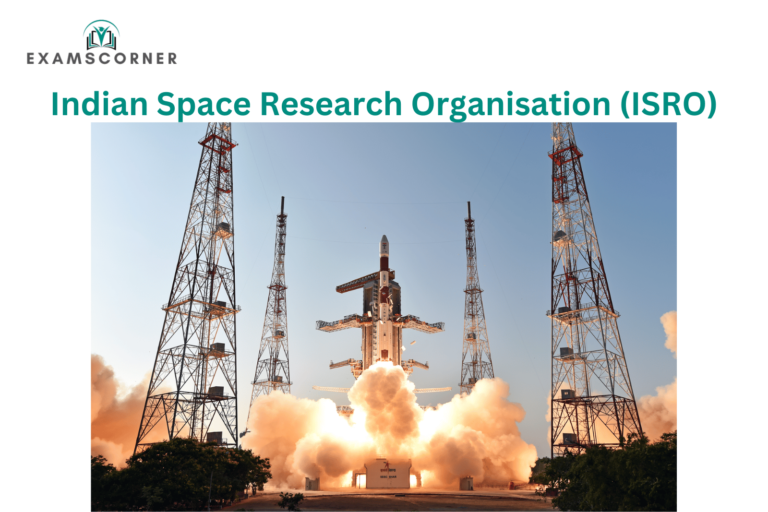The Indian Space Research Organisation (ISRO) is India’s prestigious space agency, established in 1969 to spearhead the country’s indigenous space program. Over the years, ISRO has emerged as one of the largest and most prominent space agencies globally, contributing significantly to scientific, technological, and societal advancements.
About ISRO
- Headquarters: Bengaluru, India
- Current Chairman: Dr. K. Sivan (also Secretary, Department of Space, Government of India)
- Primary Focus Areas: Broadcasting, weather forecasting, disaster management, navigation, cartography, telemedicine, distance education, and geographic information systems.
ISRO boasts an extensive fleet of remote sensing (IRS) and communication satellites (INSAT), which serve various national and global needs through its robust network of research institutes, centers, and offices.
History and Formation of ISRO
- INCOSPAR Era (1962):
- The Indian National Committee for Space Research (INCOSPAR) was established under the Department of Atomic Energy (DAE) by Prime Minister Jawaharlal Nehru.
- Dr. Vikram Sarabhai, the visionary scientist, laid the foundation for India’s space program by emphasizing its developmental potential.
- Transition to ISRO (1969):
- INCOSPAR evolved into ISRO to further expand space research and technology development.
- Department of Space (1972):
- The Department of Space was created, making ISRO a part of it. This department reports directly to the Prime Minister of India.
- Early Achievements:
- Establishment of the Thumba Equatorial Rocket Launching Station (TERLS) at Thiruvananthapuram, Kerala.
- Launch of Aryabhata, India’s first satellite, in 1975 using a Soviet launcher.
- Development of SLV-3, India’s first launch vehicle, successfully tested in 1980.
ISRO Facilities and Centers
ISRO’s diverse operations are supported by specialized facilities, including:
- Vikram Sarabhai Space Centre (VSSC), Thiruvananthapuram: Focuses on launch vehicle development.
- Liquid Propulsion Systems Centre (LPSC), Thiruvananthapuram: Develops propulsion systems.
- Satish Dhawan Space Centre (SDSC-SHAR), Sriharikota: Serves as the primary launch site.
- Space Applications Centre (SAC), Ahmedabad: Works on satellite payloads.
- National Remote Sensing Centre (NRSC), Hyderabad: Specializes in remote sensing data analysis.
Milestones in ISRO’s Journey
Sounding Rockets and Early Missions
- Rohini-75 (RH-75): First Indian-made sounding rocket, launched in 1967.
- Aryabhata (1975): First Indian satellite, launched by the Soviet Union.
- SLV-3 (1980): First indigenous launch vehicle, placing the Rohini Satellite in orbit.
Satellites and Communication Systems
- INSAT-1B (1983): The foundation of the INSAT system, now one of Asia’s largest communication satellite networks.
- IRS-1A (1988): India’s first indigenous remote-sensing satellite, enabling applications in agriculture, water resources, urban planning, and more.
Innovative Technologies and Launch Systems
- Launch Vehicles:
- PSLV (Polar Satellite Launch Vehicle): Known for its precision in launching satellites into sun-synchronous orbits.
- GSLV (Geosynchronous Satellite Launch Vehicle): Designed for heavier payloads into geostationary orbits.
- GSLV Mk-III (LVM): India’s most powerful rocket, essential for the Gaganyaan manned mission.
- Scramjet Engine (2016): Successful test of supersonic combustion engines for reusable launch vehicles.
Iconic Missions
- Chandrayaan-1 (2008): India’s first lunar mission, confirming water on the Moon.
- Mangalyaan (2014): Mars Orbiter Mission, making India the first nation to succeed in its maiden Mars mission.
- Record Satellite Launch (2017): ISRO launched 104 satellites in a single PSLV mission.
- Gaganyaan Mission (Ongoing): India’s first manned space mission, with advanced technology for crew safety and re-entry systems.
ISRO’s Applications and Contributions
- Remote Sensing:
- India’s IRS satellite constellation supports agriculture, urban planning, water resource management, and disaster response.
- Navigation Systems:
- GAGAN: A GPS-aided system developed with the Airport Authority of India for civil aviation.
- IRNSS/NAVIC: A regional navigation satellite system catering to Indian positioning needs.
- Education and Student Satellites:
- Encouraging academic participation through projects like Kalamsat-V2, Pratham, Swayam, and more.
- Societal Applications:
- Telemedicine, distance education, weather forecasting, and disaster management.
Vision and Objectives of ISRO
Vision:
“Harness space technology for national development while pursuing space science research and planetary exploration.”
Objectives:
- Development of advanced launch vehicles and satellite technology.
- Expansion of the INSAT program for telecommunication and developmental applications.
- Strengthening the IRS program for environmental monitoring and resource management.
- Promoting space-based research for societal benefits and planetary exploration.
Significance of ISRO in Global Space Science
- ISRO has established itself as a global low-cost provider of space services, creating milestones in technological advancements while maintaining cost efficiency.
- Its missions like Mangalyaan and Chandrayaan have earned India recognition as a major player in the space domain.
Conclusion
The Indian Space Research Organisation (ISRO) is a testament to India’s scientific capabilities and aspirations. With its focus on innovation, affordability, and societal impact, ISRO continues to break barriers in space exploration and technology. From launching satellites for global clients to enabling advanced navigation systems for India, ISRO is a cornerstone of the nation’s progress in science and technology.



